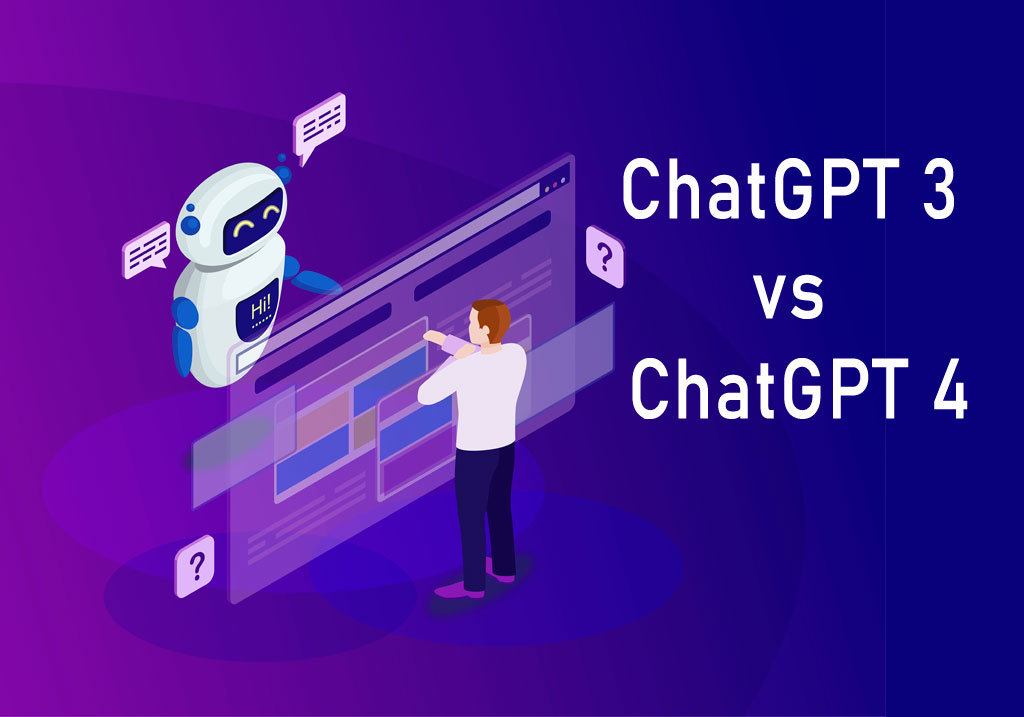As the field of artificial intelligence advances at a rapid pace, the capabilities of language models like OpenAI’s ChatGPT have grown significantly. With the recent release of GPT-4, it’s time to compare the two models and evaluate their strengths and weaknesses. In this comprehensive guide, we will examine the critical differences between ChatGPT 3 and ChatGPT 4 and analyze their impact on various applications.
Table of Contents
- Introduction: Understanding ChatGPT
- 1. Parameters: A Key Differentiator
- 2. Modality: From Text to Multimodal Inputs
- 3. Performance: Improved Accuracy and Fluency
- 4. Factual Accuracy and Reduced Hallucinations
- 5. Context Length: Improved Memory and Coherence
- 6. Multilingual Capabilities: Enhanced Language Understanding
- 7. Advanced Problem-Solving: From Maths to Science
- 8. Programming Power: Code Generation and Debugging
- 9. Image and Graphics Understanding
- 10. Addressing Bias and Inappropriate Responses
- Conclusion
Introduction: Understanding ChatGPT
ChatGPT is a powerful language model developed by OpenAI, based on the Generative Pre-trained Transformer (GPT) architecture. It processes vast amounts of text data to generate human-like responses, making it an incredibly versatile tool for businesses, marketers, and individuals alike. GPT-4, the latest version of ChatGPT, expands the capabilities of its predecessor, GPT-3.5, by incorporating more data, computing power, and multimodal functionality.
1. Parameters: A Key Differentiator
GPT 3 vs. GPT 4: Parameters Explained
Parameters are adjustable internal variables that help a language model learn and create text. The more parameters a model has, the more powerful and capable it is. When comparing GPT 3 vs. GPT 4, it’s essential to consider the parameters on which these two language models are trained.
GPT-3.5 was released with 175 billion parameters, making it one of the largest language models at the time. Although OpenAI has not officially announced the number of parameters in GPT-4, it’s safe to assume that it greatly surpasses the 175 billion parameters of GPT-3.5.
What Does This Mean for Users?
The increased number of parameters in GPT-4 means that the model can better learn and generalize patterns from the data it’s trained on. This allows GPT-4 to generate more coherent, contextual, and appropriate text, making it more capable than GPT-3.5 in tasks requiring deeper understanding and creativity.
2. Modality: From Text to Multimodal Inputs
Unimodal vs. Multimodal
A significant difference between GPT 3 vs. GPT 4 lies in their modality. GPT-3.5 is a unimodal model, meaning it can only accept text inputs. On the other hand, GPT-4 is a multimodal model, capable of understanding different modes of information, including text and images.
Real-World Applications
The addition of multimodal capabilities in GPT-4 opens up a wide range of potential applications. For example, GPT-4 can generate captions for images, analyze trends in graphs, or even describe the contents of a photo. This makes GPT-4 a more versatile and powerful tool compared to GPT-3.5, which is limited to text inputs and responses.
3. Performance: Improved Accuracy and Fluency
Measuring Performance in Language Models
The performance of a language model refers to how well it responds based on the input it receives. It shows how well the language model understands language and produces meaningful responses. Quality is typically evaluated based on perplexity, accuracy, and fluency.
GPT 3 vs. GPT 4: Performance Comparison
GPT-4 has more parameters and multimodal capabilities than GPT-3.5, giving it a significant performance advantage. It can produce intelligent and creative responses to various types of texts and images, such as research papers, poetry, legal briefs, and more. GPT-4’s increased performance also translates to better results in tasks like text completion, translation, and summarization.
4. Factual Accuracy and Reduced Hallucinations
Hallucinations in Language Models
Hallucination refers to a language model’s tendency to generate responses that don’t make sense or are irrelevant to the input received. This occurs because the model relies on its primary training data or knowledge to generate responses based on learned patterns.
GPT-3.5 has a 15% to 20% chance of hallucination, while GPT-4, according to OpenAI’s CEO Sam Altman, “hallucinates significantly less.”
Trustworthiness and Reliability
As GPT-4 is less prone to hallucinations, it is more likely to provide accurate and relevant responses. This improvement in factual accuracy makes GPT-4 a more reliable and trustworthy AI companion than GPT-3.5 in various applications, including natural language processing, chatbots, and automated customer service.
5. Context Length: Improved Memory and Coherence
Token Limits and Language Models
A language model’s token limit determines how much text it can process at once. The larger the token limit, the better the model can handle longer conversations and maintain coherence and context.
GPT-3.5 had a token limit of 4,000 tokens (equivalent to 3,125 words), while GPT-4 boasts a maximum token limit of 32,000 (equivalent to 25,000 words).
GPT 3 vs. GPT 4: Handling Long Conversations
The increased token limit in GPT-4 means it can better follow long conversations without losing context or coherence. This advantage makes GPT-4 more suitable for applications that require in-depth analysis or discussion, such as customer support or research.
6. Multilingual Capabilities: Enhanced Language Understanding
GPT 3 vs. GPT 4: Language Proficiency
Both GPT-3.5 and GPT-4 are proficient in multiple languages. However, GPT-4 outperforms its predecessor in multilingual tasks, making it more accessible to non-English speakers.
GPT-4 has demonstrated accuracy in up to 26 languages and can handle tasks such as translation, summarization, and sentiment analysis in these languages. This improved language understanding makes GPT-4 a more versatile and inclusive tool for users worldwide.
7. Advanced Problem-Solving: From Maths to Science
GPT 3 vs. GPT 4: Tackling Complex Problems
GPT-4 demonstrates a strong ability to solve complex mathematical and scientific problems, which GPT-3.5 struggles with. GPT-4 can solve advanced calculus problems or simulate chemical reactions more effectively than its predecessor, making it a valuable resource for students, researchers, and professionals alike.
Expanding the Range of Subjects
GPT-4’s advanced processing power and language modeling capabilities allow it to analyze complex scientific texts and provide insights and explanations easily. As the technology continues to evolve, it is likely that GPT-4 will become even more adept at a wider range of subjects and tasks.
8. Programming Power: Code Generation and Debugging
GPT 3 vs. GPT 4: Programming Capabilities
GPT-4’s programming capabilities have gained significant attention due to its ability to generate code snippets or debug existing code more efficiently than GPT-3.5. This makes it a valuable resource for software developers, as it can help condense weeks of work into just a few short hours.
Potential Applications in Software Development
GPT-4’s enhanced programming capabilities can be applied to tasks such as generating code for training machine learning models, fixing errors in existing code, optimizing performance, and even designing graphical user interfaces (GUIs).
9. Image and Graphics Understanding
GPT 3 vs. GPT 4: Analyzing Visual Data
One of the most significant differences between GPT-3.5 and GPT-4 is their ability to analyze and interpret images and graphics. GPT-4 can understand and comment on images and graphics, while GPT-3.5 is limited to text.
Applications in Education and Content Creation
GPT-4’s ability to analyze images and graphics opens up a range of potential applications in education and content creation. For example, GPT-4 can describe the content of a photo, identify trends in a graph, or generate captions for images.
10. Addressing Bias and Inappropriate Responses
The Challenge of Bias in AI Language Models
Language models, like GPT-3.5 and GPT-4, face the challenge of addressing biases present in their training data. These biases can lead to politically biased, offensive, or harmful content generated by the AI model.
GPT 3 vs. GPT 4: Ethical Responsibility
GPT-4 implements mechanisms to minimize undesirable results, increasing its reliability and ethical responsibility. GPT-4 is less likely to generate biased or inappropriate content than GPT-3.5, making it a more trustworthy AI companion.
Conclusion
In the battle between ChatGPT 3 vs ChatGPT 4, GPT-4 emerges as the clear winner. Its increased parameters, multimodal capabilities, and improved performance make it a more powerful and versatile tool for a wide range of applications.
From content creation to customer service, GPT-4 has the potential to revolutionize the way businesses and individuals communicate with artificial intelligence. As ChatGPT continues to evolve, the future of AI-driven communication looks more promising than ever.






